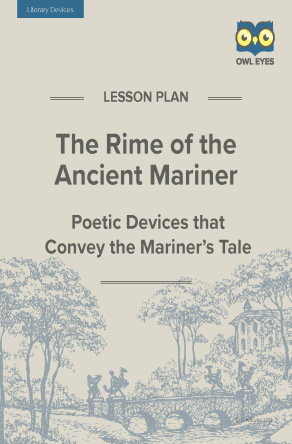The Rime of the Ancient Mariner Literary Devices Lesson Plan
- 20 pages
- Subject: Alliteration, Imagery, Metaphor, Personification, Rhyme, Simile, Tone, Lesson Plans and Educational Resources
- Common Core Standards: RL.9-10.1, RL.9-10.4, RL.9-10.5
- Grade Levels: 8, 9, 10, 11
Additional The Rime of the Ancient Mariner Resources
Product Description
Poetry Devices that Convey the Mariner’s Tale
This lesson plan focuses on imagery, figurative language, and sound devices employed by Coleridge in “The Rime of the Ancient Mariner.” Students will identify and analyze examples of imagery created through figurative language and identify and examine examples of various sound devices, including meter, rhyme, repetition, and alliteration; they will explain how imagery and musicality impact the poem. In studying these poetry devices in “The Rime of the Ancient Mariner,” students will be better able to describe the poem’s dreamlike atmosphere.
Skills: close reading, identifying and analyzing examples of various poetry devices, interpreting the effects of various poetry devices
Learning Objectives: By the end of this lesson, students will be able to
- identify and describe examples of imagery in the text.
- explain how various images in the text are created through figurative language (simile, metaphor, personification, and onomatopoeia).
- identify and analyze examples of rhyme, rhythm, repetition, and alliteration in the text.
- analyze and explain how imagery, figurative language, and sound devices create the poem’s mysterious, fantastic, dreamlike atmosphere.
About This Document
Owl Eyes lesson plans have been developed to meet the demanding needs of today’s educational environment and bridge the gap between online learning and in-class instruction. The main components of each plan include the following:
- An introduction to the text
- A step-by-step guide to lesson procedure
- Previous and following lesson synopses for preparation and extension ideas
- A collection of handouts and worksheets complete with answer keys
Each of these comprehensive, 60-minute plans focus on promoting meaningful interaction, analytical skills, and student-centered activities, drawing from the Common Core Standards for English Language Arts and the expertise of classroom teachers.
Introduction to the Lesson
In 1798, friends and literary colleagues William Wordsworth and Samuel Taylor Coleridge published Lyrical Ballads, a collection of poems to which Coleridge contributed four works, among them “The Rime of the Ancient Mariner.”
Revolutionary in poetic thought, style, and substance, Lyrical Ballads played a primary role in establishing Romanticism in English literature, and “The Rime of the Ancient Mariner” endures as a Romantic masterpiece in world literature. Structured in six parts, the poem is a narrative that tells a dramatic tale of the sea. Through the protagonist, an old sailor compelled to relate the strange events he once experienced on a fateful voyage, Coleridge develops the poem’s primary theme: spiritual redemption through love.
The plot in “The Rime of the Ancient Mariner” is gripping, its supernatural elements unforgettable. It is in the narrative’s poetic elements, however, that Coleridge’s intensely romantic imagination and consummate artistry are most evident. The language is beautiful and often hypnotic, punctuated by riveting scenes and haunting images. The stanzas are melodic, filled with rhythms and rhymes that draw the reader into a mysterious, dreamlike atmosphere. Through Coleridge’s skill in weaving a tapestry of vivid images and musical sounds, the reader, like the wedding guest who listens to the old mariner’s tale, is entranced. As the spellbinding story unfolds, reality gives way to Coleridge’s romantic vision, and spiritual truth is revealed.
Worksheet Excerpt: Identifying and Analyzing Poetry Devices
As you work in your group to identify and analyze examples of your assigned poetry device(s), refer to your handouts (“Imagery and Figurative Language” and “Sound Devices in Poetry”), and follow these instructions in completing the class activity:
-
Have the members of your group look for passages in different parts of the poem that feature examples of the poetry device(s). When some examples have been located, discuss them as a group, and decide which are the best examples of the poetry device(s). Choose two to analyze together, and write them down.
-
When you have chosen two examples of the poetry device(s), confer as a group in analyzing them. Have one person in the group act as the group’s recorder and take notes over your group’s answers to these questions:
-
Which poetry device is featured in this passage from the poem?
-
Does the use of this device help readers identify or understand an overall theme in the poem? If so, how?
-
Does this device contribute in creating atmosphere or mood in the poem? If so, describe the atmosphere or mood, and explain how the device contributes to it.
-
Does using this device give readers a more complete understanding of the mariner, the setting, or a particular event? If so, how?
-
Does using this device make the story sound authentic (true) or imaginary and dreamlike? Why?
- Have one group member highlight the passages that feature your group’s poetry-device examples, and write annotations that reflect the group’s analysis. Your group’s notes should be used in writing the annotations. Make sure everyone in the group agrees with the content in the annotations.







